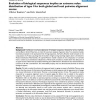Free Online Productivity Tools
i2Speak
i2Symbol
i2OCR
iTex2Img
iWeb2Print
iWeb2Shot
i2Type
iPdf2Split
iPdf2Merge
i2Bopomofo
i2Arabic
i2Style
i2Image
i2PDF
iLatex2Rtf
Sci2ools
115
Voted
BMCBI
2008
2008
Evolution of biological sequences implies an extreme value distribution of type I for both global and local pairwise alignment s
Background: Confidence in pairwise alignments of biological sequences, obtained by various methods such as Blast or Smith-Waterman, is critical for automatic analyses of genomic data. Two statistical models have been proposed. In the asymptotic limit of long sequences, the Karlin-Altschul model is based on the computation of a P-value, assuming that the number of high scoring matching regions above a threshold is Poisson distributed. Alternatively, the Lipman-Pearson model is based on the computation of a Z-value from a random score distribution obtained by a Monte-Carlo simulation. Z-values allow the deduction of an upper bound of the P-value (1/Z-value2) following the TULIP theorem. Simulations of Z-value distribution is known to fit with a Gumbel law. This remarkable property was not demonstrated and had no obvious biological support. Results: We built a model of evolution of sequences based on aging, as meant in Reliability Theory, using the fact that the amount of information sha...
| Added | 09 Dec 2010 |
| Updated | 09 Dec 2010 |
| Type | Journal |
| Year | 2008 |
| Where | BMCBI |
| Authors | Olivier Bastien, Eric Maréchal |
Comments (0)

